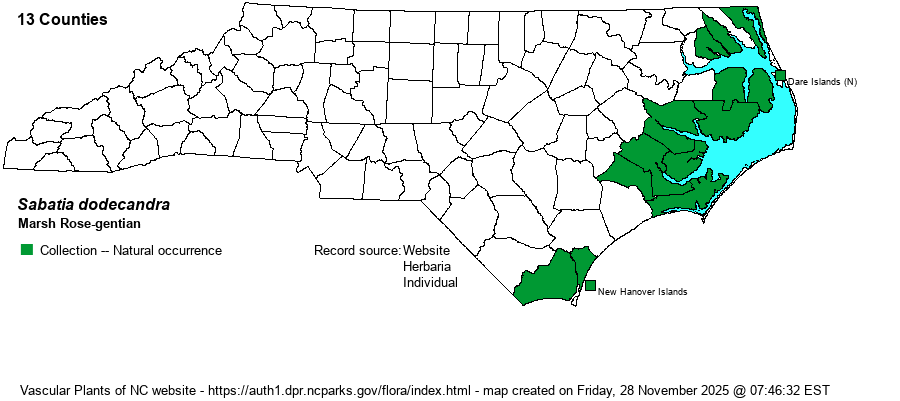| Author | (L.) Britton, Sterns, & Poggenburg | |
| Distribution | Limited to counties with tidal marshes, from the VA line to the SC line.
This is a coastal species, ranging form CT south to GA and reportedly northern FL. Inland records refer to misidentifications. | |
| Abundance | Formerly infrequent to frequent, but declining owing to increase in Phragmites, perhaps rising sea levels, and other factors impacting tidal fresh to slightly brackish marshes. Now uncommon in the northern and central counties, and rare in the southern counties. The NCNHP lists this correctly as a Watch List species, but it probably will need to be moved to Significantly Rare in the next few years. The State Rank is currently S2S3, but S2 may be more to the truth now. | |
| Habitat | This is a species restricted to tidal marshes in NC, mainly in tidal freshwater marshes, less so in oligohaline marshes. It also grows on canal banks where there is some tidal influence. | |
| Phenology | Blooms from June to August, and fruits from August to October. | |
| Identification | This is a fairly slender but erect species, growing to about 2 feet tall, with scattered alternate and mostly ascending branches. As with most others in the genus, it has paired and mostly lanceolate leaves, about 1.5-2 inches long, with an acute tip. At the tip of each branch and stem is a large and spectacular flower, consisting of mainly 10-12 petals (and sepals), bright rose to rose-pink, with yellow at the base of each petal. Each flower is about 2 inches across. Rather similar is S. kennedyana, which was formerly included in the same species but as a separate variety, but that species is limited in NC to the Waccamaw River drainage and thus is not a tidal species in the state. It also is a much taller plant, often to 3 feet tall or more, and the main branches are opposite as opposed to mostly alternate in S. dodecandra. S. dodecandra is one of the more beautiful of coastal marsh wildflowers, but the exotic Common Reed (Phragmites australis) is crowding out this species from some former locations, and it is not clear how rising water levels will impact this and other native marsh species. In some parts of the northeastern counties, rising sea levels have actually converted cypress and white cedar forests to shrub thickets or marshes, though its impact on this species is unclear. A new survey of tidal marshes around Currituck, Albemarle, and the mainland side of Pamlico sounds is badly needed. | |
| Taxonomic Comments | Formerly S. kennedyana was included within this species, by some authors, including RAB (1968). There are no taxonomic issues now.
| |
| Other Common Name(s) | Swamp Pink Gentian, Perennial Rose-gentian | |
| State Rank | S2S3 | |
| Global Rank | G5? | |
| State Status | W1 | |
| US Status | | |
| USACE-agcp | OBL link |
| USACE-emp | OBL link |

